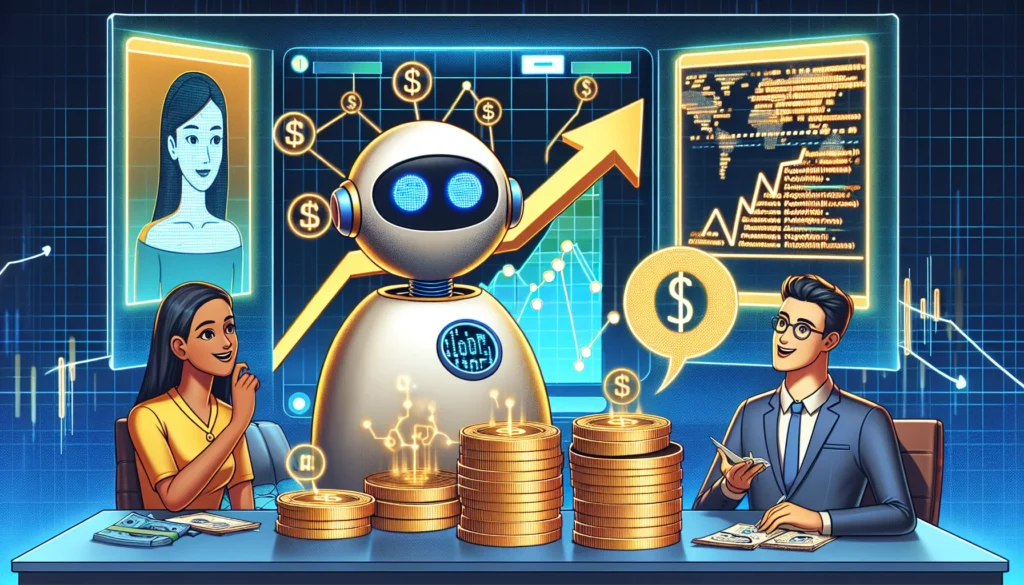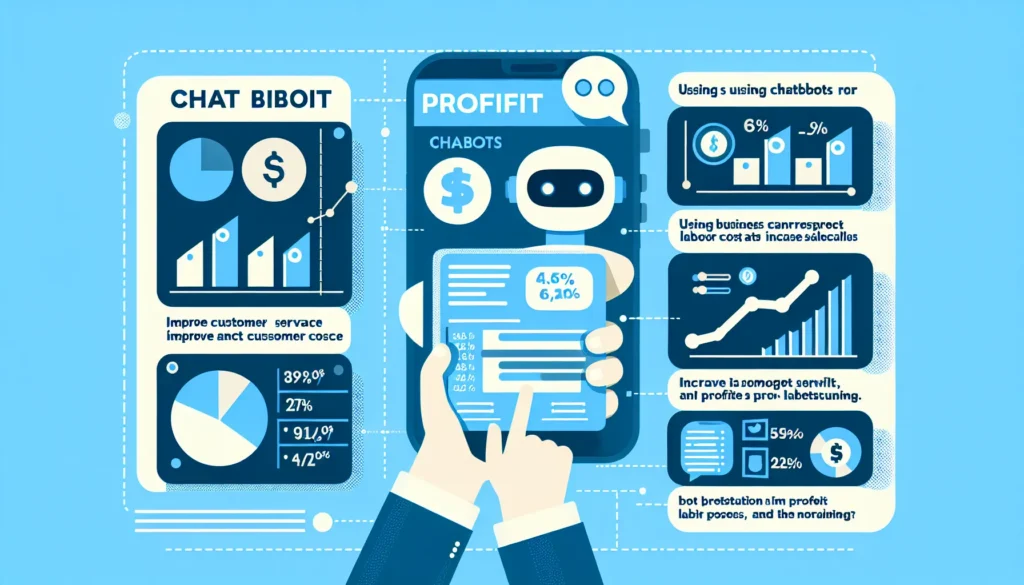Profit from Chatbots: Why Chatbots Are Your 2025 Revenue Game-Changer
“Did you know chatbots could generate $142 billion in global retail revenue by 2025?” (Source: Juniper Research).
By 2025, chatbots will become integral to business strategies, transforming customer interactions. These AI-powered tools will improve customer service and uncover new revenue possibilities, creating avenues for innovative profit generation.
Using advanced algorithms and natural language processing, chatbots deliver personalized experiences that boost customer engagement and loyalty, leading to higher sales and profits.
Chatbots—AI-powered conversational agents—are no longer just customer service tools. By 2025, they will drive sales, automate workflows, and personalize user experiences at scale.
This article unveils how to profit from chatbots using cutting-edge strategies, debunking myths, and leveraging trends like generative AI and hyper-personalization. Whether you’re a startup founder, marketer, or enterprise leader, this guide is your roadmap to chatbot profitability.
The Evolution of Chatbots: From Scripted Tools to Revenue Engines

Chatbots have undergone a remarkable transformation, evolving from simple, scripted response systems to sophisticated AI-driven conversational agents capable of delivering personalized customer experiences. This shift has enhanced the user experience and opened up new avenues for monetization.
By utilizing advanced algorithms and machine learning, modern chatbots can understand user intent, predict needs, and offer tailored solutions, effectively turning every interaction into an opportunity to drive revenue and build brand loyalty.
Chatbots have evolved from rigid, scripted responders to dynamic AI entities capable of natural conversations. By 2025, advancements in large language models (LLMs) like GPT-5 and multimodal AI (text, voice, image) will blur the lines between human and machine interactions.
Key Trends Shaping 2025’s Chatbot Economy
1: The Rise of Generative AI: Generative AI is revolutionizing chatbots by enabling personalized and natural interactions. Utilizing deep learning, it creates human-like text for smoother and more engaging communication.
Businesses are quickly using generative AI to improve customer service, automate content, and provide personalized user experiences, transforming how we engage with digital assistants. Tools like ChatGPT help bots create marketing content, close deals, and promote products.
2: Hyper-Personalization: Hyper-personalization uses AI to quickly analyze large amounts of data, allowing businesses to offer tailored content, recommendations, and services that connect with each customer personally.
By analyzing user preferences, behaviors, and emotions, AI systems can deliver a more engaging customer experience that anticipates user needs. Bots use data like purchase history and emotions to provide personalized recommendations.
3: Voice-First Interfaces: With the growing use of smart speakers and voice-activated devices, voice-first interfaces are getting smarter. Using AI, they can accurately understand and process human speech, making interactions with machines more natural.
Voice-first design simplifies integrating AI into daily life, offering personalized suggestions, reminders, and assistance without screens or manual input. Voice-enabled chatbots will dominate smart homes and wearable devices.
4: Blockchain Integration: Blockchain is transforming AI personalization by boosting data security and privacy. With decentralized ledgers, personal data stays secure, giving users more control over their information and its use by AI.
This integration builds trust in AI-driven personalization by protecting data from unauthorized access and breaches, enabling users to enjoy tailored experiences. Additionally, decentralized bots strengthen security in transactions and loyalty programs.
Box 1: Debunking 3 Myths About Chatbot Profitability

Myth 1: “Chatbots are only for big corporations.”
Reality: Chatbots have become increasingly accessible and cost-effective for businesses of all sizes. Small and medium-sized enterprises can leverage chatbot technology to enhance customer service, automate repetitive tasks, and increase sales, often with minimal upfront investment.
Chatbots can scale with a business, offering a cost-effective solution for companies at any growth stage. Tools like ManyChat and Tars let small businesses launch affordable bots within hours.
Myth 2: “Bots can’t manage complex sales.”
Reality: Modern AI chatbots can handle detailed sales processes by accurately responding to customer questions. They guide users through sales funnels, offer tailored recommendations, and even process transactions.
Using learning algorithms, these bots improve over time, adapting to meet each customer’s needs, which boosts conversion rates and satisfaction. AI tools like IBM Watson can handle complex B2B negotiations with up to 90% accuracy (Forbes).
Myth 3: “Chatbots eliminate human jobs.”
Reality: While it’s true that chatbots and other AI-driven tools are automating tasks traditionally performed by humans, they are not necessarily eliminating jobs, but evolving them. The reality is that AI often takes over repetitive and time-consuming tasks, allowing human employees to focus on more complex and creative work that requires emotional intelligence and nuanced judgment.
The growth of AI is opening up new job opportunities in areas like development, maintenance, and management of these systems, offering a fresh boost to the job market. Thoughtful AI personalization can create a balanced partnership between technology and workers, driving productivity and innovation. In fact, 70% of agents using bots report increased efficiency (Gartner).
5 Proven Strategies to Profit from Chatbots in 2025

1. Monetize via Subscription-Based Chatbot Services
Businesses can capitalize on the growing demand for personalized experiences by offering subscription-based chatbot services tailored to individual user preferences. This model ensures a steady revenue stream while providing customers with continuous value through updates, specialized content, and bespoke interactions.
Driven by cutting-edge AI, these chatbots continuously evolve their responses through user interactions, delivering superior customer satisfaction and fostering loyalty. Unlock premium chatbot solutions tailored for specialized needs like fitness coaching or financial planning. Case Study: HealthBot Inc. achieved a 200% ROI by offering AI-powered diet plans at just $29/month.
2. Leverage Chatbots for Lead Generation
- Step-by-Step: Add an AI chatbot to your website or social media. First, select a chatbot that works well with your existing systems and matches your brand tone. Program it to ask engaging questions to understand your visitors’ interests and needs.
- By initiating these chats, the AI gathers valuable data to tailor the experience and recommend products or services that fit the user’s needs. This strategy increases engagement and enhances the likelihood of converting visitors into leads.
- Deploy a lead-qualifying bot on your website.2: To further leverage AI personalization, consider implementing dynamic content on your website. This could involve changing text, images, or offers based on the user’s behavior, demographics, or past interactions with your brand.
- By customizing content to match each visitor’s needs and interests, businesses can deliver a more engaging and relevant experience, building loyalty and driving repeat visits. Use CRM tools like HubSpot for better integration. Leveraging AI personalization boosts user engagement and offers key insights into customer behavior. AI analyzes interaction data to spot patterns and preferences, helping businesses improve their marketing strategies and products.
- This adaptive approach ensures that the user experience is consistently optimized, and customers feel understood and valued, which is crucial in today’s competitive digital landscape. Use NLP to ask strategic questions (e.g., “What’s your budget?”).
Pro Tip: To use AI personalization effectively, collect and study data to understand customer habits and preferences. Use machine learning to predict needs and offer personalized recommendations that connect with each user.
This boosts customer satisfaction while encouraging engagement and loyalty, as users are more likely to revisit a platform that understands their preferences. Funny bots can increase conversion rates by 30% (HubSpot).
3. E-Commerce Chatbots: The 24/7 Salesperson
E-commerce chatbots with AI are transforming online shopping. Using customer data, they offer personalized recommendations, answer questions instantly, and simplify the buying process, working like a 24/7 salesperson.
This saves customers time and frees up customer service teams to focus on more complex issues.
Businesses are boosting customer satisfaction and repeat purchases with personalized shopping experiences powered by chatbots. These bots also allow in-chat purchases on platforms like Shopify. For instance, Sephora’s chatbot improved bookings by 11% by suggesting products tailored to specific skin types.
4. Affiliate Marketing via Conversational AI
Leveraging conversational AI for affiliate marketing can significantly enhance user engagement and conversion rates. By integrating AI-driven chatbots into affiliate marketing strategies, businesses can provide personalized product recommendations and special offers to users based on browsing history and preferences.
This improves user experience and boosts conversions by offering personalized recommendations. Collaborate with brands to promote products and include trackable links in chatbot conversations.
5. Sell Chatbot Solutions as a Service (CaaS)
Leveraging AI personalization doesn’t stop at enhancing user experience; it also opens up new revenue streams for businesses. By offering Chatbot Solutions as a Service (CaaS), companies can cater to the growing demand for sophisticated, conversational AI across various industries.
This service model allows businesses to provide personalized chatbot functionalities to other organizations, helping them to improve customer engagement, streamline operations, and gather valuable insights from user interactions.
As a result, companies that adopt CaaS can position themselves as innovative leaders in the AI space, while simultaneously capitalizing on the trend of hyper-personalized customer service. Develop custom bots for niches like real estate or healthcare. Charge $5,000+ per project.
Top 3 Google Searches on Chatbot Profitability (Answered)

Q1: “How much does it cost to build a chatbot?”
A: The cost of creating a chatbot depends on its features, the platforms it supports, and its functionality. A simple chatbot with basic replies may cost between $2,000 and $10,000.
However, for advanced bots equipped with sophisticated AI and machine learning capabilities, tailored to industries like finance or legal services, costs can soar to $20,000 or more, reflecting the intricate nature of their design and the value they offer in automating complex interactions. 0(DIYplatforms)to0(DIYplatforms)to50,000+ (enterprise AI).
Q2: “Which industries profit most from chatbots?”
A: Certainly, the industries that stand to gain the most from chatbots are those with a high volume of customer interactions and a need for quick, consistent responses.
The retail, banking, and healthcare sectors have greatly benefited from chatbots. These tools efficiently manage multiple customer inquiries simultaneously, reducing wait times and freeing up human agents to focus on more complex challenges.
Travel and hospitality businesses use chatbots to simplify bookings and offer tailored recommendations. This improves customer satisfaction, builds loyalty, and increases efficiency. E-commerce, healthcare, banking, and travel industries benefit too.
Q3: “Can chatbots replace sales teams?”
A: While chatbots are increasingly sophisticated and capable of handling a wide range of customer interactions, they are not likely to completely replace sales teams in the near future. Human sales representatives possess the ability to understand complex customer emotions, build deeper relationships, and make judgment calls that AI is currently unable to replicate fully.
However, chatbots can significantly augment the efforts of sales teams by qualifying leads, scheduling appointments, and providing instant responses to basic inquiries, allowing human salespeople to focus on higher-level tasks that require a personal touch. No—they qualify leads, letting teams focus on high-value tasks.
Tools & Platforms to Build Profitable Chatbots
| Tool | Best For | Cost |
|---|---|---|
| Dialogflow | NLP-heavy bots | Free tier |
| ManyChat | SMS/WhatsApp marketing | $15/month |
| Drift | B2B lead generation | $50/month |
3 Quick Wins to Boost Chatbot ROI in 2025
1: A/B Test Messages: Leveraging AI-driven analytics: In an era where data is king, utilizing AI to analyze chatbot interactions can provide invaluable insights. By examining patterns and user behaviors, businesses can fine-tune their bots to deliver more personalized experiences, ultimately driving higher engagement and conversion rates.
This approach not only enhances customer satisfaction but also ensures that the chatbot continually evolves to meet the ever-changing preferences of users. Try emojis vs. plain text—emojis boost engagement by 25%.
2: Add Payment Gateways: Adding payment gateways to AI-powered chats makes buying for customers. With fewer steps to complete a purchase, businesses can reduce cart abandonment and boost sales.
Moreover, when AI personalization is applied to payment processes, it can remember preferred payment methods and suggest deals or discounts based on the user’s purchase history, tailoring the shopping experience to individual preferences. Enable Stripe/PayPal in-chat for instant purchases.
3: Analyze Sentiment: By leveraging sentiment analysis, AI personalization technology can gauge the emotional tone behind customer feedback, reviews, and interactions. This nuanced understanding allows businesses to tailor their responses and services, ensuring customers feel heard and valued.
As a result, companies can build stronger relationships with their customers, foster loyalty, and enhance overall customer satisfaction by addressing concerns with empathy and precision. Tools like Sentiment Analyzer refine bot responses based on user mood.
The Future of Chatbots: Predictions from Industry Leaders
As we look ahead, industry leaders anticipate a surge in AI personalization capabilities, particularly within chatbot technologies. They predict that chatbots will evolve to understand context and history more deeply, allowing for conversations that are not just reactive but proactive, offering solutions and suggestions tailored to individual user needs before they even articulate them.
Personalization will grow with advanced machine learning and data analysis, allowing chatbots to offer highly intuitive and tailored services. Elon Musk forecasts that “AI chatbots will manage 40% of global commerce by 2030.” At the same time, concerns about data privacy will increase the need for GDPR-compliant bots (MIT Technology Review).

FAQs: Your Chatbot Profitability Questions Answered
Q1: What’s the biggest mistake businesses make with chatbots?
A: The most significant misstep businesses often make with chatbots is underestimating the importance of personalization. Many companies deploy chatbots with generic responses that fail to engage users on a deeper level.
Businesses can maximize AI chatbots by using machine learning to study customer data and provide tailored responses.
This improves user experience and builds connection and loyalty to the brand. Avoid over-automation—combine bot efficiency with human interaction.
Q2: How do I measure chatbot success?
A: Measure chatbot success by tracking key metrics like response time, resolution rate, and user retention. These KPIs help assess customer satisfaction and overall performance.
Gathering direct feedback through surveys and analyzing user sentiment helps assess the chatbot’s effect on customer experience. Monitor conversion rates, average order value, and customer satisfaction (CSAT).
Q3: Are voice chatbots worth investing in?
A: Yes, voice chatbots can be a valuable investment for improving customer service and engagement in many businesses.
As smart speakers and voice-activated devices grow in popularity, users are getting more comfortable with voice interfaces. Adding voice chatbots can improve accessibility, offer quick support, and meet the demand for hands-free help.
Moreover, they can streamline operations and potentially increase efficiency by handling routine inquiries, which allows human agents to focus on more complex issues. Yes—55% of households will use voice shopping by 2025 (OC&C Strategy Consultants).

Conclusion: Seize the Chatbot Gold Rush of 2025
By 2025, businesses without AI-powered personalization in their customer service risk falling behind. AI chatbots are now essential, providing customers with instant, customized support around the clock.
Innovative companies use this technology to boost customer satisfaction, build loyalty, and cut costs.
Those who invest in these intelligent systems are positioning themselves at the forefront of a customer service revolution that is reshaping the landscape of consumer interactions. Chatbots are no longer optional—they’re profit powerhouses. From subscription models to affiliate marketing, the strategies above will future-proof your business.
Call to Action: Adopting AI personalization isn’t just staying competitive—it’s about taking the lead in delivering the personalized experiences customers now expect. With advanced algorithms and machine learning, businesses can analyze data to predict preferences and customize their offerings.
This level of customization increases engagement, fosters brand loyalty, and ultimately drives revenue growth. It’s time to harness the power of AI to deliver services and products that resonate with your audience on a deeply personal level. Start your chatbot journey today with a free trial on ManyChat. Share your thoughts below: Which chatbot strategy excites you most?
Article Update Note: This guide is updated quarterly with the latest chatbot trends and data.


